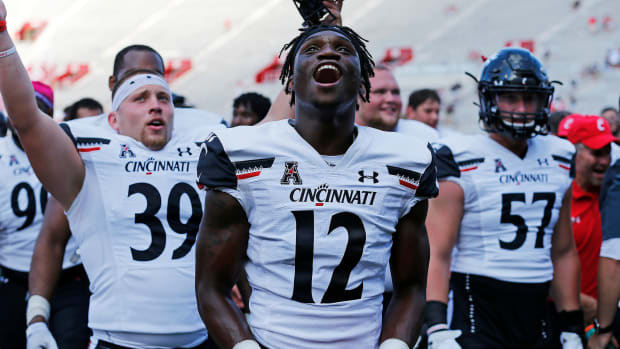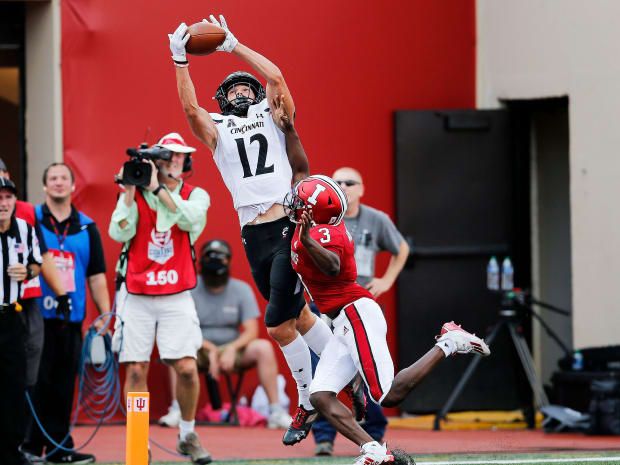Before they join the Big 12, programs like Cincy and UCF have unfinished business. Only one, though, prevailed this weekend.
Earlier this month, the Big 12 and four striver athletic programs hooked up on a Hail Mary of an idea. Hemorrhaging clout with Texas and Oklahoma on their way to the Southeastern Conference in a few years, the conference launched a prayer for continued viability by expanding. BYU, UCF, Cincinnati and Houston
answered said prayer, fulfilling their quests to upgrade into the Power 5 cartel.While those are long-haul decisions that may or may not be transformative, they bring the here-and-now into sharper focus for all four football teams. And what’s very clear is that this is no time to rest and revel in future conference prestige. The urgency to prove themselves remains, and perhaps even intensifies.
With that as context, two of the four journeyed into Power 5 stadiums Friday and Saturday: UCF was at Louisville, and Cincinnati at Indiana. The American Athletic Conference rivals both were favored, flipping the customary script when G5 visits P5.
Their weekend outcomes were wildly divergent.

Sam Greene/The Enquirer/USA TODAY Network
In Louisville Friday night, the previously unbeaten Knights left Cardinal Stadium awash in trauma. They were stunned by a 66-yard interception return with 13 seconds left for the deciding touchdown in a 42–35 loss. That was magnified by the injury to star quarterback Dillon Gabriel’s throwing shoulder on the final play—a futile, multi-lateral fiasco with no chance of succeeding. Other injuries to key players piled up as well.
As UCF regrouped to head home in the wee hours of Saturday morning, Louisville fans and players responded with raucous joy. That reaction was validation for what the Knights have accomplished as a program, going 35–4 from 2017–19. “You can tell the way they celebrated,” UCF coach Gus Malzahn said. “That was a big win for them.”
One hundred miles north of Louisville the next day, amid the limestone hills of Southern Indiana, IU showed its respect to No. 8 Cincinnati by putting 52,656 fans in the stadium—the school’s largest home crowd for a non-Big Ten game since 1987. The students showed up in force, the tailgate scene was strong, the noise was legitimate. “It’s a little different world for us,” said Bearcats coach Luke Fickell. “There’s a little bit of a bullseye.”
Cincinnati wore the target and escaped unscathed, enjoying a postgame scene that was starkly different from UCF’s. Where one program saw its season tilt very much the wrong way, the other saw everything get bigger.
As the Bearcats were celebrating in front of their large block of fans in the corner of Indiana’s Memorial Stadium, quarterback Desmond Ridder sought out his starting offensive linemen and pulled them away.
Holding the game ball in his left hand, Ridder arranged the linemen around him and had someone snap a picture of the crew. Ridder wanted the scoreboard in the background, but to his disappointment the home side had already scuttled the photographic evidence of this Bearcats triumph. Cincinnati 38, Indiana 24, was no longer on display. “That’s O.K.,” Ridder said later. “Forty years from now, we’ll know who won.”
The Cincinnati goal is a state of Indiana victory tour, with pictures to show for it. “I told the guys we'll take a picture after this when we win,” Ridder said. “And we’ll take a picture next game, too.”
Next game is the game: up the road in South Bend against 3–0 Notre Dame, Oct. 2. That matchup, plus this game at Indiana, form the potential College Football Playoff launching pad for the aspirational Bearcats. Cincinnati may be ticketed for the Big 12 in a few years, but as a Group of 5 program right now, these Power 5 road opportunities are vital proving grounds for a selection committee predisposed to look elsewhere.
That’s why beating Indiana was described as “huge” by Fickell and two of his players Saturday. For every program with big dreams, scoring quality wins against programs that have all the advantages is vital.
When the undefeated Bearcats were snubbed by the CFP selection committee last year, it was largely because they had no résumé against Power 5 competition. In 2017, undefeated UCF had just one P5 win, over a bad Maryland team. In ’18, the Knights beat Pittsburgh but lost an opportunity when a game against North Carolina was canceled due to severe weather.
So for Cincinnati, these games against preseason top 25 Indiana and current top 15 Notre Dame are the vital building blocks of serious CFP consideration. Win them both and run the table, and the best of the G5 will be much harder to ignore than usual. (Strangely enough, UCF’s loss and Gabriel’s injury could work against Cincy; the two will meet in Nippert Stadium Oct. 16, and the chance for that to be a take-notice victory for the Bearcats is now diminished.)
“This season is really big for putting Cincinnati on the map,” said Cincy linebacker Darrian Beavers. “We’re going into the Big 12 in a couple years, but this can solidify us as a top-10 program.”
With a record of 34–6 over its last 40 games, Cincinnati has established its credentials on the field. Additionally, the school is in a large TV market in a populous state that loves football and produces a ton of talent. UCF can say all those things as well, but its true power could wait years down the road as a school with a massive enrollment continues to produce tens of thousands of alums. (As it is, the school brought plenty of fans to Louisville Friday, with Churchill Downs and downtown both populated by people wearing black and gold.)
While the future is bright, the present was a bit more unsettled for UCF last winter. Tennessee hired away both UCF’s football coach (Josh Heupel) and its athletic director (Danny White) in February. UCF then turned to a rising AD (Terry Mohajir from Arkansas State) and a gifted coach on the rebound (Gus Malzahn, fired by Auburn). They saw the potential in Orlando.
“The bases were loaded when I got here,” Mohajir said. “I just had to step up to the plate.”
Mohajir said the work to get into a Power 5 conference began “the day I got here. Reading the tea leaves, looking at the landscape, I felt the opportunity was coming very soon. We prepped. We were poised and ready to position ourselves and tell our story.”
Thus when the news broke in July about Texas and Oklahoma bolting for the SEC, UCF pounced.
Mohajir told Sports Illustrated that he “had a pretty good idea” that the Big 12 application would be accepted when the Knights opened the season on Thursday, Sept. 2, against Boise State. When UCF fell behind in that game 21–0, there was a pit in his stomach. But the Knights rallied to take the lead, then clinched the game with an interception inside their own 10-yard line with about two minutes to play. On the sideline, Mohajir was caught by TV cameras going wild after the play.
“I was thinking, ‘Oh, this is not going to be good for the narrative (if UCF lost to another G5 team that was not gaining Big 12 admission),’ “ Mohajir says. “I said to myself, ‘We’ve got to win this game.’ “
Cincinnati was ready to shoot its shot with the Big 12 as well, having lobbied the league hard for membership a few years earlier. The Bearcats formally were approved as a future member on Friday, Sept. 10, and the next day they had a flag with the Big 12 logo on it flying at their home game against Murray State.
“A lot of late nights working with our marketing and social media teams,” athletic director John Cunningham says of the final days before everything was formalized.

Sam Greene/The Enquirer/USA TODAY Network
These road games against P5 competition were the first real statement opportunities since Big 12 membership went official. And for quite a while Saturday, the Bearcats appeared headed to the same fate as the Knights.
Cincinnati was in quicksand offensively, its line committing pre-snap penalties over and over. Ridder was misfiring high. It took the Bearcats until the second quarter to record a first down, and they trailed 14–0 late in the first half.
A targeting penalty on Indiana linebacker Micah McFadden turned the game around. “From there, we flipped the switch,” Cincinnati receiver Alec Pierce said. The Bearcats scored seven plays later, then picked off Michael Penix Jr. and kicked a field goal to reduce the deficit to a manageable 14–10 at halftime.
Fickell’s veteran team never panicked. Ridder found his bearings in the second half, also making big plays with his feet. Tre Tucker returned a kickoff 99 yards for a TD. And Cincinnati’s formidable defense came up with three big stops inside its own 10-yard line: the Hoosiers were stopped on downs once; threw an interception in the end zone then fumbled inside the five.
“We’re tough and nasty,” Beavers said. “When our backs are against the wall, we play our best.”
Cincinnati survived wearing the bullseye on the road against a Big Ten team. Could the Bearcats possibly be favored at Notre Dame and wear it again? On paper, it seems possible. In the big picture, it seems surreal.
“I hope we’re past having to prove ourselves,” Pierce said. “But I think people are still going to doubt us, to view us as a Group of 5 team.”
Those days are dwindling. But for now, the game in Notre Dame Stadium Oct. 2 presents another take-a-picture-with-the-scoreboard opportunity. Perhaps the biggest Cincinnati has ever had.
More College Coverage:
• The New Big 12 Should Be Just Fine in Men's Hoops
• Big Ten–ACC–Pac-12 Alliance Could See Season-Long Matchups
• Which Coaches Should USC Target?

0 Comments:
Post a Comment